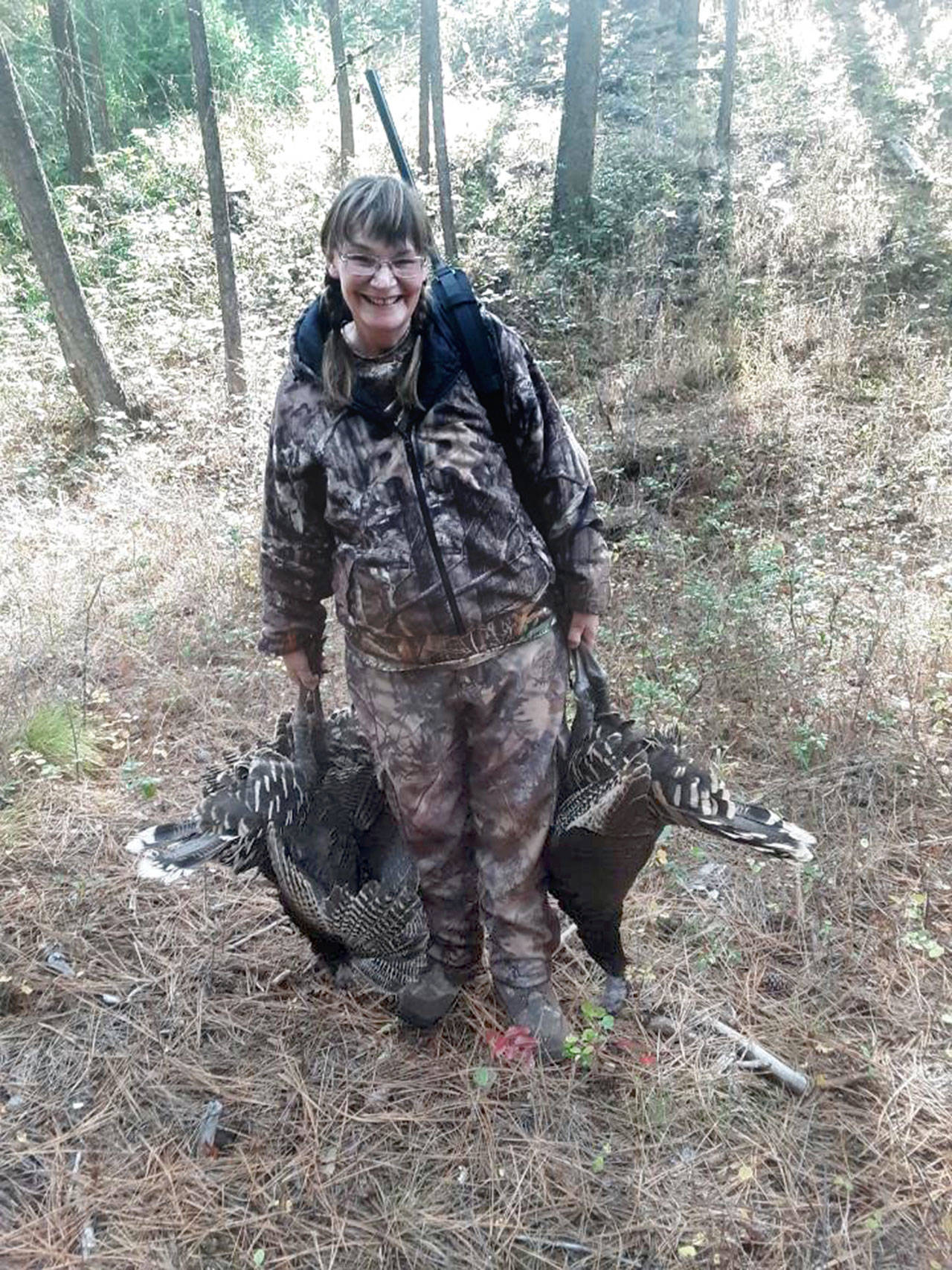SWAPPING OUT AN archery bow for a turkey load, Port Angeles’ Cookie Singhose-Allison recently returned from a successful hunt in the opposite corner of the state.
Singhose-Allison bagged three Merriam’s turkey hens while hunting in the northeast section of the state near Chewelah and as far north as Northport along the Columbia River.
These were Singhose-Allison’s first turkeys and her first fall turkey hunt after going after turkeys in the spring of 2019.
In 1960, the state Department of Fish and Wildlife introduced Merriam’s turkeys into the northeast and south central portions of the state for hunting purposes. Rio Grande and Eastern subspecies also have been added to other suitable habitat around the state since then. About 50 Eastern turkeys are bagged in Western Washington each year, mostly in southwest Washington and the Columbia Gorge.
But Eastern Washington offers up a gaggle of gobblers. I’ve been stopped on busy boulevards by road-crossing toms while driving in south Spokane in recent years.
“It’s just loaded with turkeys up there,” Singhose-Allison said.
“I went to the archery shop over there and was told that hunters are always coming in complaining about the turkey problem. They make a mess. They will get into your barn, get into grain, poop on the hay and yeah, generally act like juvenile delinquents. And there’s so many of them.”
Singhose-Allison watched turkey hunting videos on YouTube to grow her knowledge.
She was set to return for a spring turkey hunt, but the pandemic forced a delay until the fall and a change in approach with the season.
“Spring is different because the gobblers are in mating season, so there’s a lot more calling and it’s pretty exciting,” Singhose-Allison said. “It’s a lot of fun to be talking to them and trying out your calls. In fall, they don’t talk a lot, they still gobble, you just have to find them.
“I have four different calls now, but i think I get the best response just with my voice. I’ve got a slate call, a box call and a hand-made call made out of a turkey wing, but I can’t use it, it’s more decorative.”
The fall turkey hunt is similar to deer hunting, according to a 2019 Turkey Hunting guide authored by Fish and Wildlife. “Turkeys are generally in larger flocks made up of hens and their offspring or smaller groups of toms. Look for travel corridors and feeding areas that the birds are using. Set up an ambush point on travel routs between the roost tree and the feeding area.”
Singhose-Allison found recently harvested fields provided feeding sites for the birds.
“It’s hilly country with pine trees with no underbrush and a lot of open fields and the turkeys will travel down and the way farming is done, the combines don’t pick up all the grain, so turkeys are down, there first thing in the morning to feed,” Singhose-Allison said.
“I didn’t know exactly how close I could get to them in fall. Turkeys have excellent eyesight, but no sense of smell. But if you move a muscle, they are like elk and they scatter.”
Singhose-Allison used a .12 gauge shotgun to bag the birds.
“In the spring I purchased a different barrel, a full-choke barrel, so the shot pattern is tighter,” Singhose-Allison said.
Singhose-Allison was hunting with her husband Tim. The pair had been elk hunting in Idaho before stopping off in Chewelah for some turkey time.
“He was stoked to be there with me,” Singhose-Allison said. We had just spent five days in Idaho elk hunting and we saw everything but elk. We were hunting in an area that’s had a drop in population. But we saw two bull moose, actually see a lot of moose in the area we were hunting. And we saw white-tailed deer.”
Singhose-Allison said there are other hunters on the North Olympic Peninsula who head east of the mountains for whitetails and also add turkey tags to their trips.
And she said Thanksgiving dinner was taken care of.
“I did cook up a turkey thigh over there in a crockpot, that was about all we had to cook with, when we came back from an afternoon hunt,” Singhose-Allison said. “There was no gamey taste, the meat was just falling off the bone.”
Wild turkey meat is all dark meat, no plump white breast meat available with these birds.
And she got a proper sendoff by an area flock.
“While I’m getting ready to pack the truck and come home, I’m just hearing gobbling, gobbling, gobbling. And I’m thinking, ‘What is going on and it seemed like the whole flock came out to say goodbye. And I’m like, ‘It’s fine, guys. I’ll be back in the spring.”
________
Sports reporter Michael Carman can be contacted at 360-406-0674 or mcarman@peninsuladailynews.com.

